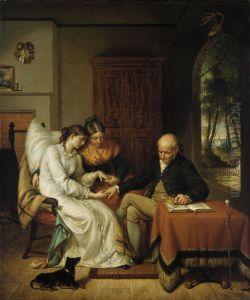Henry Peters Gray Paintings
Henry Peters Gray was an accomplished American portrait and genre painter, born on June 23, 1819, in New York City. His artistic journey began at an early age, and he was primarily self-taught, although he did study for a brief period under the tutelage of portraitist Daniel Huntington. Gray's passion for art was evident as he sought to refine his skills, and in pursuit of artistic growth, he traveled to Europe in 1842. This trip allowed him to immerse himself in the study of the Old Masters, and he spent considerable time in Italy, where the Renaissance artworks had a profound impact on his style and technique.
Upon returning to the United States, Gray established himself as a prominent figure in the New York art scene. He became known for his refined portraits, which were characterized by their elegant composition and his attention to detail. His subjects often included notable figures of the day, and he was particularly adept at capturing the nuances of their character and status. Gray was also recognized for his genre paintings, which often depicted historical and allegorical themes. His work was marked by a sense of idealism, as he strove to represent the noble and moral aspects of his subjects.
Throughout his career, Gray was an active member of the art community and held various positions of influence. He was elected an associate of the National Academy of Design in 1842, and a full academician in 1848. From 1869 to 1871, he served as the president of the National Academy, a testament to his reputation and leadership within the art world. His paintings were exhibited widely and received accolades for their artistic merit.
Gray's legacy is one of a dedicated artist who contributed significantly to American art in the mid-19th century. He bridged the classical traditions of European painting with the burgeoning American aesthetic, creating works that resonated with audiences of his time. Henry Peters Gray passed away on November 12, 1877, leaving behind a body of work that continues to be appreciated for its historical significance and artistic beauty.








